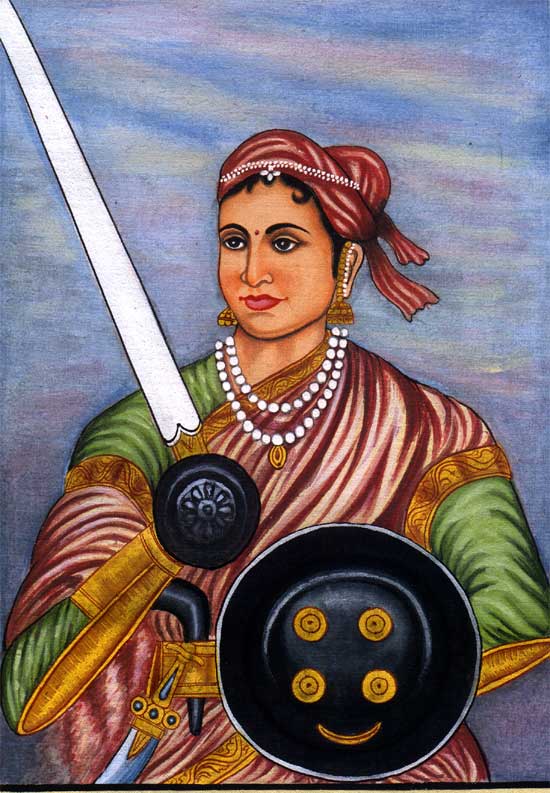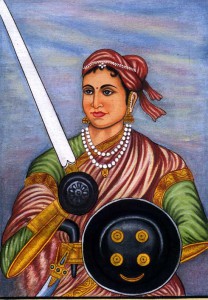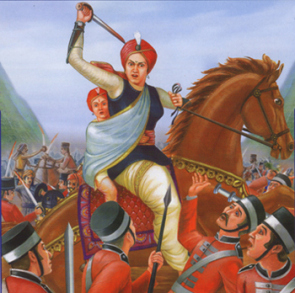
The Queen Rani Lakshmibai
Rani Lakshmibai or Rani Laxmibai was the famed monarch of Jhansi and an embodiment of courage at the time of British reign in India. She was one of the front ranking leaders of the Indian Rebellion of 1857 and a symbol of resistance to British rule.
Her valiant battle to ensure that her adopted son was recognized as the legal ruler of Jhansi may not have ultimately resulted in victory, but she continues to remain a beacon for the upcoming generations of freedom fighters.
Origin
According to historical accounts, Rani Laxmi Bai, also known as ‘Jhansi Ki Rani’, was born on November 19th, 1828, in a town called Varanasi. At the time of birth, she was named ‘Manikarnika’, and was given the nickname ‘Manu’. She was of Maharashtrian origin and her parents were Brahmins. Rani Laxmi Bai’s mother died when she was 4, and the Peshwa of Bithoor district, for whom her father worked, looked after Rani Laxmi Bai’s education and early years.
She had a bright spark of fierce independence even at a young age, and her studies included horsemanship, archery, and self defense. She was then married to Raja Gangadhar Rao in 1842, who was the king of Jhansi. Her one major passion was horses, and her daily routine included hours of horseback riding, which was a form of exercise for her. She gave birth to one son, who died 4 months later. Her husband, who was the king lost his mental stability, and left everything to Rani Laxmi bai, who became the sole monarch for the city of Jhansi.
Rani Laxmi bai was a brave woman who stood up to the British when they wanted to seize her kingdom and declare ownership. In her fight for independence, Rani Laxmi bai showed utmost audacity, and the British army feared her undying determination, and military skill. During the 1858 battle against the British army, Rani Laxmi Bai lost her life, but the British were not convinced till her body had been burnt. This speaks volumes of how petrified the British were of the one Indian woman who challenged them with her patriotic zeal and sovereignty.
Style & Attire
The most unique quality about Rani Laxmi bai was her style of dressing. Even though she went out to battle in a sari, she dressed it up like a man. The sari was always tied close to her body, and draped in the typical Maharashtrian style, which is known as the ‘Nauvari sari’. During battle, she wore a scarf tied around her head in order to keep her hair out of the way, while fiercely fighting off the British army. She also wore minimal jewelry.
Simple pair of gold or copper earrings, along with a belt tied around her waist were typical adornments used by the brave queen. She never left her palace without her sword, hanging proudly by her side.
Her swordsmanship and skill with horses even impressed the British. One thing that stood out in her attire was the bindi or tilak she adorned her forehead with. This gave her a traditional trademark, unique and different from the rest. Rani Laxmi Bai was not fond of grandeur, and her simple approach to life appeared in her sense of style as well. She wore cotton or muslin saris, and she draped them in a practical manner, rather than a stylish one.
Present Day Scenario
After Rani Laxmi Bai’s death, the aroma of bravery and feminism ran is Maharashtra. Hence, the women took forward the the style and vogue of Lakshmi Bai ahead by donning the ‘Nauvari sari‘ with the same practical style that the Rani had possessed. The 9-yard Nauvari sari is still in vogue in Maharashtra and all over India, and holds the same value it did centuries ago.
Even today, several movies and television programmes celebrate the unique aura and bravery that the fierce queen of India showcased. Little children generally opt to dress up like Rani Laxmi Bai for ‘fancy dress’ competitions due to the majestic Indian pride the attire carries.
Global Appeal
Rani Laxmi Bai is always regarded as the brave and powerful queen of India. She is put in the same light as the Goddess Durga, who according to Hindu mythology was known as the invincible and strong deity.
Besides this, several ornate statues have been made across India, which uphold the honor and pride that Indians feel with regards to the indomitable Indian queen. Songs and poems of patriotism have been written, which pay tribute to the one and only ’Jhansi ki Rani’. Her style and appeal serve as a reminder of true Indian feminism, which is simple, yet strong.
Reference
Categories: Fashion Cults, Royalty



